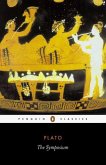13,99 €
inkl. MwSt.
Versandfertig in 2-4 Wochen

7 °P sammeln
- Broschiertes Buch
- Merkliste
- Auf die Merkliste
- Bewerten Bewerten
- Teilen
- Produkt teilen
- Produkterinnerung
- Produkterinnerung
- Weitere 7 Ausgaben:
- Broschiertes Buch
- Broschiertes Buch
- eBook, ePUB
- eBook, ePUB
- eBook, ePUB
- eBook, ePUB
- eBook, PDF
Aristotle's Art of Rhetoric is a treatise concerning the theory and practice of the most dynamic form of discourse in Classical Greece. The Rhetoric was a touchstone for all later ancient writers on the subject, from the Stoics to Cicero.
Andere Kunden interessierten sich auch für
![The Art of Rhetoric The Art of Rhetoric]() AristotleThe Art of Rhetoric14,99 €
AristotleThe Art of Rhetoric14,99 €![On the Good Life On the Good Life]() CiceroOn the Good Life16,99 €
CiceroOn the Good Life16,99 €![The Prince The Prince]() Niccolo MachiavelliThe Prince13,99 €
Niccolo MachiavelliThe Prince13,99 €![The Basic Works of Aristotle The Basic Works of Aristotle]() AristotleThe Basic Works of Aristotle25,99 €
AristotleThe Basic Works of Aristotle25,99 €![The Republic The Republic]() PlatoThe Republic11,99 €
PlatoThe Republic11,99 €![The Nature of Things The Nature of Things]() LucretiusThe Nature of Things18,99 €
LucretiusThe Nature of Things18,99 €![The Symposium The Symposium]() PlatoThe Symposium13,99 €
PlatoThe Symposium13,99 €-
-
-
Aristotle's Art of Rhetoric is a treatise concerning the theory and practice of the most dynamic form of discourse in Classical Greece. The Rhetoric was a touchstone for all later ancient writers on the subject, from the Stoics to Cicero.
Hinweis: Dieser Artikel kann nur an eine deutsche Lieferadresse ausgeliefert werden.
Hinweis: Dieser Artikel kann nur an eine deutsche Lieferadresse ausgeliefert werden.
Produktdetails
- Produktdetails
- Oxford World's Classics
- Verlag: Oxford University Press
- Seitenzahl: 288
- Erscheinungstermin: 1. Juli 2018
- Englisch
- Abmessung: 198mm x 128mm x 17mm
- Gewicht: 204g
- ISBN-13: 9780198724254
- ISBN-10: 019872425X
- Artikelnr.: 49963042
- Herstellerkennzeichnung
- Libri GmbH
- Europaallee 1
- 36244 Bad Hersfeld
- gpsr@libri.de
- Oxford World's Classics
- Verlag: Oxford University Press
- Seitenzahl: 288
- Erscheinungstermin: 1. Juli 2018
- Englisch
- Abmessung: 198mm x 128mm x 17mm
- Gewicht: 204g
- ISBN-13: 9780198724254
- ISBN-10: 019872425X
- Artikelnr.: 49963042
- Herstellerkennzeichnung
- Libri GmbH
- Europaallee 1
- 36244 Bad Hersfeld
- gpsr@libri.de
Robin Waterfield is a writer, living in Greece. His previous translations for Oxford World's Classics include Plato's Republic and five other editions of Plato's dialogues, Aristotle's Physics, Herodotus' Histories, Polybius' Histories, Plutarch's Greek Lives and Roman Lives and Hellenistic Lives, Euripides' Orestes and Other Plays and Heracles and Other Plays, Xenophon's The Expedition of Cyrus, Demosthenes' Selected Speeches and The First Philosophers: The PreSocratics and the Sophists. He is the author of Dividing the Spoils: The War for Alexander the Great's Empire (Oxford, 2011) and Taken at the Flood (Oxford, 2014). Harvey Yunis is Andrew W. Mellon Professor of Humanities and Professor of Classics at Rice University. He is the author of Taming Democracy: Models of Political Rhetoric in Classical Athens (Cornell University Press, 1996) and Demosthenes: On the Crown (Cambridge University Press, 2001). He has edited Written Texts and the Rise of Literate Culture in Ancient Greece (Cambridge University Press, 2003; 2007) and Plato, Phaedrus (Cambridge University Press, 2011) and translated Demosthenes, Speeches 18 and 19 (University of Texas Press, 2005).
The Art of Rhetoric - Aristotle Translated with an Introduction and Notes
by Hugh Lawson-Tancred
Preface
Introduction:
1. The Importance of Ancient Rhetoric
2. The Historical Background to the Rhetoric
3. Rhetoric as Techne
4. Psychology in the Rhetoric
5. Style and Composition
6. The Rhetorical Legacy of Aristotle
7. The Translation
THE ART OF RHETORICSection One: Introductory
Chapter 1.1. The Nature of Rhetoric
PART ONE: DEMONSTRATIONSection Two: The Genres of Oratory
Chapter 1.2. The Definition of Rhetoric
Chapter 1.3. The Genres
Section Three: Deliberation
Chapter 1.4. The Province of Deliberation
Chapter 1.5. Happiness
Chapter 1.6. The Good and the Expedient
Chapter 1.7. Relative Expediency
Chapter 1.8. Constitutions
Section Four: Display
Chapter 1.9. Display Oratory
Section Five: Litigation
Chapter 1.10. Injustice
Chapter 1.11. Pleasure
Chapter 1.12. The Criminal Mind
Chapter 1.13. Crime and Punishment
Chapter 1.14. Relatively Serious Crimes
Chapter 1.15. Non-technical Proofs
PART TWO: EMOTION AND CHARACTERSection Six: Emotion
Chapter 2.1. The Role of Emotion and Character
Chapter 2.2. Anger
Chapter 2.3. Calm
Chapter 2.4. Friendship and Enmity
Chapter 2.5. Fear and Confidence
Chapter 2.6. Shame
Chapter 2.7. Favour
Chapter 2.8. Pity
Chapter 2.9. Indignation
Chapter 2.10. Envy
Chapter 2.11. Jealousy
Section Seven: Character
Chapter 2.12. Youth
Chapter 2.13. Old Age
Chapter 2.14. Prime
Chapter 2.15. Birth
Chapter 2.16. Wealth
Chapter 2.17. Power
PART THREE: UNIVERSAL ASPECTSSection Eight: Common Topics
Chapter 2.18. The Role of Common Topics
Chapter 2.19. The Topics of Possibility
Chapter 2.20. Example
Chapter 2.21. Maxim
Chapter 2.22. Enthymeme
Chapter 2.23. Demonstrative Common Topics
Chapter 2.24. Illusory Topics
Chapter 2.25. Refutation
Chapter 2.26. Amplification
Section Nine: Style
Chapter 3.1. Historical Preliminary
Chapter 3.2. Clarity
Chapter 3.3. Frigidity
Chapter 3.4. Simile
Chapter 3.5. Purity
Chapter 3.6. Amplitude
Chapter 3.7. Propriety
Chapter 3.8. Rhythm
Chapter 3.9. Syntax
Chapter 3.10. Wit and Metaphor
Chapter 3.11. Vividness
Chapter 3.12. Suitability to Genre
Section Ten: Composition
Chapter 3.13. Narration and Proof
Chapter 3.14. The Introduction
Chapter 3.15. Prejudice
Chapter 3.16. Narration
Chapter 3.17. Proof and Refutation
Chapter 3.18. Altercation
Chapter 3.19. The Epilogue
Notes
Bibliography
by Hugh Lawson-Tancred
Preface
Introduction:
1. The Importance of Ancient Rhetoric
2. The Historical Background to the Rhetoric
3. Rhetoric as Techne
4. Psychology in the Rhetoric
5. Style and Composition
6. The Rhetorical Legacy of Aristotle
7. The Translation
THE ART OF RHETORICSection One: Introductory
Chapter 1.1. The Nature of Rhetoric
PART ONE: DEMONSTRATIONSection Two: The Genres of Oratory
Chapter 1.2. The Definition of Rhetoric
Chapter 1.3. The Genres
Section Three: Deliberation
Chapter 1.4. The Province of Deliberation
Chapter 1.5. Happiness
Chapter 1.6. The Good and the Expedient
Chapter 1.7. Relative Expediency
Chapter 1.8. Constitutions
Section Four: Display
Chapter 1.9. Display Oratory
Section Five: Litigation
Chapter 1.10. Injustice
Chapter 1.11. Pleasure
Chapter 1.12. The Criminal Mind
Chapter 1.13. Crime and Punishment
Chapter 1.14. Relatively Serious Crimes
Chapter 1.15. Non-technical Proofs
PART TWO: EMOTION AND CHARACTERSection Six: Emotion
Chapter 2.1. The Role of Emotion and Character
Chapter 2.2. Anger
Chapter 2.3. Calm
Chapter 2.4. Friendship and Enmity
Chapter 2.5. Fear and Confidence
Chapter 2.6. Shame
Chapter 2.7. Favour
Chapter 2.8. Pity
Chapter 2.9. Indignation
Chapter 2.10. Envy
Chapter 2.11. Jealousy
Section Seven: Character
Chapter 2.12. Youth
Chapter 2.13. Old Age
Chapter 2.14. Prime
Chapter 2.15. Birth
Chapter 2.16. Wealth
Chapter 2.17. Power
PART THREE: UNIVERSAL ASPECTSSection Eight: Common Topics
Chapter 2.18. The Role of Common Topics
Chapter 2.19. The Topics of Possibility
Chapter 2.20. Example
Chapter 2.21. Maxim
Chapter 2.22. Enthymeme
Chapter 2.23. Demonstrative Common Topics
Chapter 2.24. Illusory Topics
Chapter 2.25. Refutation
Chapter 2.26. Amplification
Section Nine: Style
Chapter 3.1. Historical Preliminary
Chapter 3.2. Clarity
Chapter 3.3. Frigidity
Chapter 3.4. Simile
Chapter 3.5. Purity
Chapter 3.6. Amplitude
Chapter 3.7. Propriety
Chapter 3.8. Rhythm
Chapter 3.9. Syntax
Chapter 3.10. Wit and Metaphor
Chapter 3.11. Vividness
Chapter 3.12. Suitability to Genre
Section Ten: Composition
Chapter 3.13. Narration and Proof
Chapter 3.14. The Introduction
Chapter 3.15. Prejudice
Chapter 3.16. Narration
Chapter 3.17. Proof and Refutation
Chapter 3.18. Altercation
Chapter 3.19. The Epilogue
Notes
Bibliography
The Art of Rhetoric - Aristotle Translated with an Introduction and Notes
by Hugh Lawson-Tancred
Preface
Introduction:
1. The Importance of Ancient Rhetoric
2. The Historical Background to the Rhetoric
3. Rhetoric as Techne
4. Psychology in the Rhetoric
5. Style and Composition
6. The Rhetorical Legacy of Aristotle
7. The Translation
THE ART OF RHETORICSection One: Introductory
Chapter 1.1. The Nature of Rhetoric
PART ONE: DEMONSTRATIONSection Two: The Genres of Oratory
Chapter 1.2. The Definition of Rhetoric
Chapter 1.3. The Genres
Section Three: Deliberation
Chapter 1.4. The Province of Deliberation
Chapter 1.5. Happiness
Chapter 1.6. The Good and the Expedient
Chapter 1.7. Relative Expediency
Chapter 1.8. Constitutions
Section Four: Display
Chapter 1.9. Display Oratory
Section Five: Litigation
Chapter 1.10. Injustice
Chapter 1.11. Pleasure
Chapter 1.12. The Criminal Mind
Chapter 1.13. Crime and Punishment
Chapter 1.14. Relatively Serious Crimes
Chapter 1.15. Non-technical Proofs
PART TWO: EMOTION AND CHARACTERSection Six: Emotion
Chapter 2.1. The Role of Emotion and Character
Chapter 2.2. Anger
Chapter 2.3. Calm
Chapter 2.4. Friendship and Enmity
Chapter 2.5. Fear and Confidence
Chapter 2.6. Shame
Chapter 2.7. Favour
Chapter 2.8. Pity
Chapter 2.9. Indignation
Chapter 2.10. Envy
Chapter 2.11. Jealousy
Section Seven: Character
Chapter 2.12. Youth
Chapter 2.13. Old Age
Chapter 2.14. Prime
Chapter 2.15. Birth
Chapter 2.16. Wealth
Chapter 2.17. Power
PART THREE: UNIVERSAL ASPECTSSection Eight: Common Topics
Chapter 2.18. The Role of Common Topics
Chapter 2.19. The Topics of Possibility
Chapter 2.20. Example
Chapter 2.21. Maxim
Chapter 2.22. Enthymeme
Chapter 2.23. Demonstrative Common Topics
Chapter 2.24. Illusory Topics
Chapter 2.25. Refutation
Chapter 2.26. Amplification
Section Nine: Style
Chapter 3.1. Historical Preliminary
Chapter 3.2. Clarity
Chapter 3.3. Frigidity
Chapter 3.4. Simile
Chapter 3.5. Purity
Chapter 3.6. Amplitude
Chapter 3.7. Propriety
Chapter 3.8. Rhythm
Chapter 3.9. Syntax
Chapter 3.10. Wit and Metaphor
Chapter 3.11. Vividness
Chapter 3.12. Suitability to Genre
Section Ten: Composition
Chapter 3.13. Narration and Proof
Chapter 3.14. The Introduction
Chapter 3.15. Prejudice
Chapter 3.16. Narration
Chapter 3.17. Proof and Refutation
Chapter 3.18. Altercation
Chapter 3.19. The Epilogue
Notes
Bibliography
by Hugh Lawson-Tancred
Preface
Introduction:
1. The Importance of Ancient Rhetoric
2. The Historical Background to the Rhetoric
3. Rhetoric as Techne
4. Psychology in the Rhetoric
5. Style and Composition
6. The Rhetorical Legacy of Aristotle
7. The Translation
THE ART OF RHETORICSection One: Introductory
Chapter 1.1. The Nature of Rhetoric
PART ONE: DEMONSTRATIONSection Two: The Genres of Oratory
Chapter 1.2. The Definition of Rhetoric
Chapter 1.3. The Genres
Section Three: Deliberation
Chapter 1.4. The Province of Deliberation
Chapter 1.5. Happiness
Chapter 1.6. The Good and the Expedient
Chapter 1.7. Relative Expediency
Chapter 1.8. Constitutions
Section Four: Display
Chapter 1.9. Display Oratory
Section Five: Litigation
Chapter 1.10. Injustice
Chapter 1.11. Pleasure
Chapter 1.12. The Criminal Mind
Chapter 1.13. Crime and Punishment
Chapter 1.14. Relatively Serious Crimes
Chapter 1.15. Non-technical Proofs
PART TWO: EMOTION AND CHARACTERSection Six: Emotion
Chapter 2.1. The Role of Emotion and Character
Chapter 2.2. Anger
Chapter 2.3. Calm
Chapter 2.4. Friendship and Enmity
Chapter 2.5. Fear and Confidence
Chapter 2.6. Shame
Chapter 2.7. Favour
Chapter 2.8. Pity
Chapter 2.9. Indignation
Chapter 2.10. Envy
Chapter 2.11. Jealousy
Section Seven: Character
Chapter 2.12. Youth
Chapter 2.13. Old Age
Chapter 2.14. Prime
Chapter 2.15. Birth
Chapter 2.16. Wealth
Chapter 2.17. Power
PART THREE: UNIVERSAL ASPECTSSection Eight: Common Topics
Chapter 2.18. The Role of Common Topics
Chapter 2.19. The Topics of Possibility
Chapter 2.20. Example
Chapter 2.21. Maxim
Chapter 2.22. Enthymeme
Chapter 2.23. Demonstrative Common Topics
Chapter 2.24. Illusory Topics
Chapter 2.25. Refutation
Chapter 2.26. Amplification
Section Nine: Style
Chapter 3.1. Historical Preliminary
Chapter 3.2. Clarity
Chapter 3.3. Frigidity
Chapter 3.4. Simile
Chapter 3.5. Purity
Chapter 3.6. Amplitude
Chapter 3.7. Propriety
Chapter 3.8. Rhythm
Chapter 3.9. Syntax
Chapter 3.10. Wit and Metaphor
Chapter 3.11. Vividness
Chapter 3.12. Suitability to Genre
Section Ten: Composition
Chapter 3.13. Narration and Proof
Chapter 3.14. The Introduction
Chapter 3.15. Prejudice
Chapter 3.16. Narration
Chapter 3.17. Proof and Refutation
Chapter 3.18. Altercation
Chapter 3.19. The Epilogue
Notes
Bibliography







